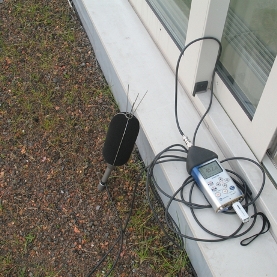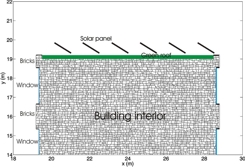Ecological and economic advantages
Vegetated roof tops have a large number of ecological and economic advantages. Most often cited is the increase in thermal insulation of roof systems, leading to a decrease in energy costs, both in hot and cold climates. Green roofs may also store a large amount of water, and as a consequence, significantly reduce the runoff peak of rainfall events. Since urban areas consist mainly of impervious surfaces, green roofs help to reduce flooding risks. Green roofs may contribute to an improved air quality as well, in both a direct an indirect way. Plant structures like leaves and branches filter airborne particles out of the air. Indirectly, the temperature reduction in cities leads to a reduced production of atmospheric ozone. Uncovered roofs are further subject to very large surface temperature fluctuations, inducing stresses on the roof system and materials. Vegetation and substrate moderate these temperature fluctuations, and act therefore as a protection for the roof membrane. It was shown that life cycle costs of extensive green roofs are lower than those of exposed flat roofs, even without considering potential energy savings. Other advantages are an increase in carbon dioxide uptake, an improved biodiversity in urban areas, and the creation of a more pleasant environment for citizens.
Positive for sound environment
There are also important acoustical benefits of green roofs. The presence of the substrate largely decreases sound transmission compared to an uncovered roof. This could be important, e.g., to reduce noise annoyance from a airplane flying over. Since the exterior of a non-vegetated roof is most often made of acoustically rigid materials, there is also potential in reducing acoustic waves diffracting over houses and buildings.
Tuneable
Numerical analysis with the FDTD method showed the ability of green roofs to reduce sound pressure levels at non-exposed side of houses and buildings (J. Sound Vib. 317, 781-799, 2008). While low frequencies are hardly affected, attenuations up to 10 dB where found at 1 kHz. In case of extensive green roofs, the layer tickness is an important parameter. This is a tuneable parameter: it determines at what frequency (band) destructive interference occurs just above the green roof. Another important parameter is the fraction of the roof covered with green. In a second step, various building configurations where positive effects might be expected by the presence of a green roof were evaluated for road traffic noise (Build. Environ. 44, 1081-1087, 2009).
Field studies
A number of in-situ measurements have been performed to evaluate the acoustical effect of a green roof in practice. In a first step, diffraction measurements over the roof of a building were performed in absence of the green roof. After placement of the green roof, these measurements were repeated with identical source-receiver configuration. Situations with single diffraction (green roof on building extension with receiver near a building facade) and double diffraction (fully shielded location) were considered. A single diffraction case with an acoustic green roof improvement exceeding 10 dB was found for sound frequencies between 400 Hz and 1250 Hz, even for a 4.5 m long roof. For the double diffraction cases the green roof improvement is less frequency-dependent and cases with positive effects up to 5 dB and up to 10 dB were found (Build. Environ. 46, 729-738, 2011).
Effect of rain
The substrate properties are important for the acoustic performance of a green roof. Dry substrates absorb sound more efficiently than when wet. In a long-term monitoring experiment near the edge of a building equipped with a green roof, the effect of substrate moisture content in response to rainfall events has been measured (Build. Environ. 82, 1-8, 2014). Sound diffracting over a green roof showed to be sensitive to the substrate moisture content in a specific sound frequency range, more precisely between 250 Hz and 1250 Hz. The difference in noise attenuation between a rather dry state (0.1 m3/m3) of the substrate and the maximum observed volumetric water content (close to saturation, 0.33 m3/m3) could range up to 10 dB. However, additional calculations show that the impact of the water content in an extensive green roof substrate for road traffic noise abatement is expected to be limited, and only leads to variations in performance of at maximum 1.5-2 dBA.
Solar panels on green roofs
Solar panels should be used in tandem with green roofs. Besides increased biodiversity on the roof and higher solar energy harvesting efficiency during hot periods, such panels are also predicted to increase noise shielding (Build. Acoust. 25, 219-232, 2018). With increasing inclination angle and especially when there are no gaps between the bottom of the panels and the green roof, positive effects become more pronounced. For a 45° inclination angle, more than 5 dBA additional road traffic noise reduction is theoretically predicted by the presence of the solar panels (placed on a 10-cm-thick limestonebased green roof on a flat-roofed building). This effect is the result of direct shielding by the panels, periodicity effects, and the enhanced interaction between the sound waves diffracting over the roof and the absorption provided by the green roof (substrate). So the dilemma/competition for roof space between vegetated roofs and solar panels is a false one.
Figure 1
Simulated sound pressure levels at the back of a building equipped with an extensive green roof, relative to a fully rigid roof, in function of substrate thickness S.

Figure 2
Measuring the acoustical effect of an extensive green roof in situ.

Figure 3
Solar panels on green roof.
